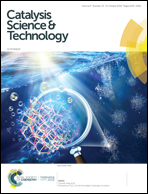The synergistic role of double vacancies within AgGaS2 nanocrystals in carrier separation and transfer for efficient photocatalytic hydrogen evolution†
Abstract
Vacancy engineering, a commonly used strategy to tune photocatalytic performances, has received tremendous attention. While enormous endeavors have demonstrated novel single-vacancy dependent photocatalysis phenomena, the influence of co-existence of multiple vacancies on photocatalysis remains relatively unexplored. Herein, a series of AgGaS2 nanocrystals featuring double-vacancy (silver vacancies and sulfur vacancies) characteristics have been successfully synthesized, where vacancy concentration control can be realized via simply adjusting the molar ratio of Ag and Ga precursors. The photocatalytic results show that the variation in the concentrations of double vacancies within the nanocrystals exerts a remarkable influence on photocatalytic hydrogen evolution, with the best performance in terms of efficient photocatalytic hydrogen production (up to 5.93 mmol g−1 h−1) coming from the sample with Ag–P/Ga–P = 0.507. We further demonstrate how the double vacancies synergistically contribute to photocatalytic activity by affecting the separation and transfer efficiency of photo-generated carriers.



 Please wait while we load your content...
Please wait while we load your content...